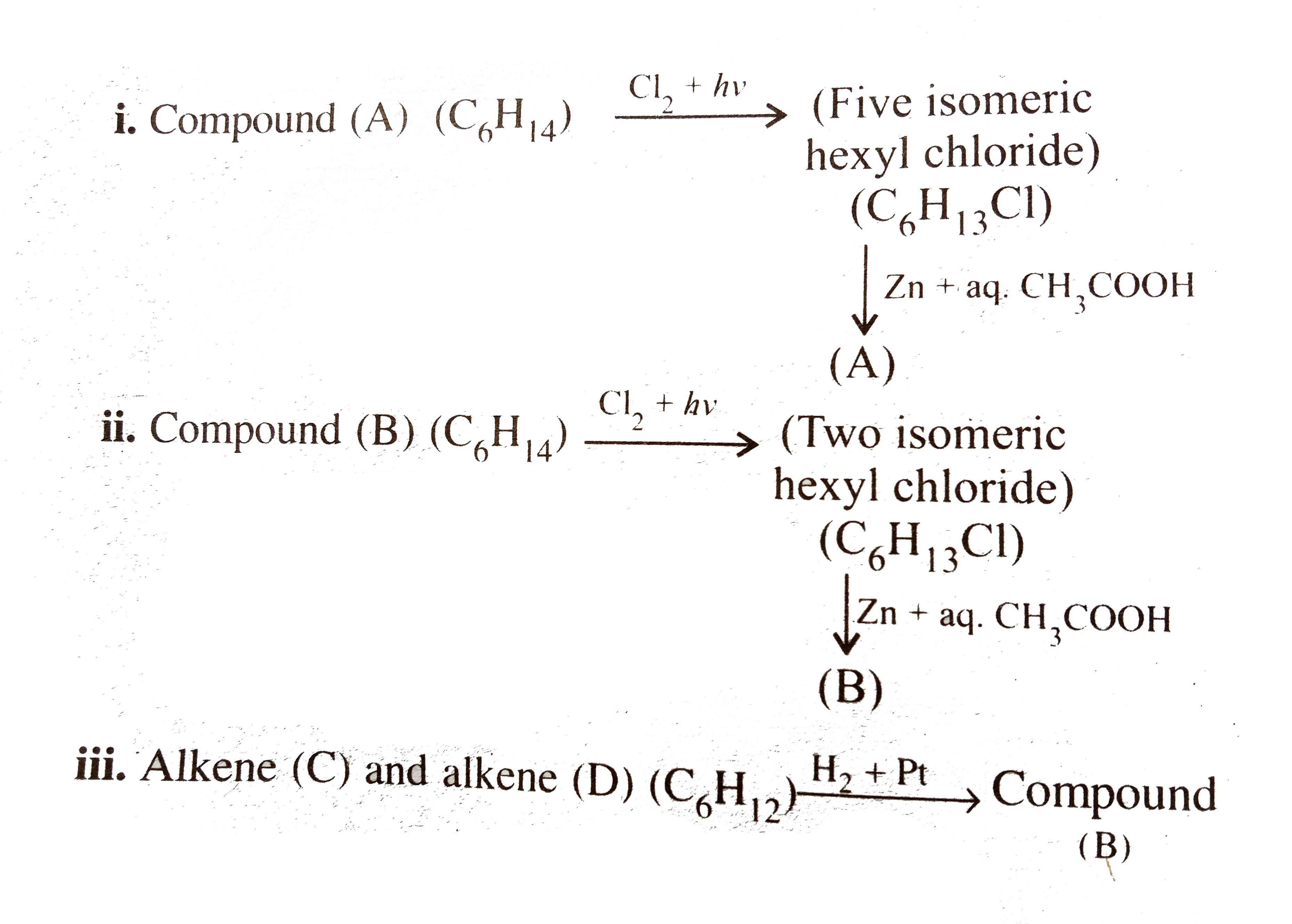When chromite ore FeCr2O4 is fuse with NaOH in presence of air, a yellow coloured compound (A) is obtained which on acidification with dilute sulphuric acid gives a compound (B). Compound (B) on reaction with KCl formed an orange colured crystalline compound (C).
(i) Write the formula of the compounds (A),(B) and (C).
(ii) Write one use of compounds (C).
To solve the problem step by step, we will identify the compounds formed in the reactions involving chromite ore and their subsequent transformations.
Step 1: Reaction of Chromite Ore with NaOH in Presence of Air
When chromite ore FeCr2O4 is fused with sodium hydroxide (NaOH) in the presence of air (which provides oxygen), a yellow colored compound is formed. The reaction can be represented as follows:
FeCr2O4+4NaOH+3O2→2Na2CrO4+Fe2O3+4H2O
From this reaction, we can identify:
- Compound (A): Na2CrO4 (sodium chromate)
Step 2: Acidification of Compound (A)
Next, when compound (A) Na2CrO4 is acidified with dilute sulfuric acid H2SO4, it forms another compound:
Na2CrO4+H2SO4→Na2Cr2O7+Na2SO4+2H2O
From this reaction, we can identify:
- Compound (B): Na2Cr2O7 (sodium dichromate)
Step 3: Reaction of Compound (B) with KCl
Finally, when compound (B) Na2Cr2O7 reacts with potassium chloride KCl, it yields an orange colored crystalline compound:
Na2Cr2O7+2KCl→K2Cr2O7+2NaCl
From this reaction, we can identify:
- Compound (C): K2Cr2O7 (potassium dichromate)
Summary of Compounds
- Compound (A): Na2CrO4
- Compound (B): Na2Cr2O7
- Compound (C): K2Cr2O7
Step 4: Use of Compound (C)
One of the uses of compound (C), potassium dichromate K2Cr2O7, is that it is a powerful oxidizing agent used in various chemical reactions, including the preparation of azo compounds.
Final Answers
(i)
- Compound (A): Na2CrO4
- Compound (B): Na2Cr2O7
- Compound (C): K2Cr2O7
(ii) One use of compound (C) is that it is a powerful oxidizing agent.
When chromite ore FeCr2O4 is fused with sodium hydroxide (NaOH) in the presence of air (which provides oxygen), a yellow colored compound is formed. The reaction can be represented as follows:
- Compound (A): Na2CrO4 (sodium chromate)
Next, when compound (A) Na2CrO4 is acidified with dilute sulfuric acid H2SO4, it forms another compound:
- Compound (B): Na2Cr2O7 (sodium dichromate)
Finally, when compound (B) Na2Cr2O7 reacts with potassium chloride KCl, it yields an orange colored crystalline compound:
- Compound (C): K2Cr2O7 (potassium dichromate)
- Compound (A): Na2CrO4
- Compound (B): Na2Cr2O7
- Compound (C): K2Cr2O7
One of the uses of compound (C), potassium dichromate K2Cr2O7, is that it is a powerful oxidizing agent used in various chemical reactions, including the preparation of azo compounds.
(i)
- Compound (A): Na2CrO4
- Compound (B): Na2Cr2O7
- Compound (C): K2Cr2O7
Topper's Solved these Questions
- XII BOARDSBOOK - XII BOARD PREVIOUS YEAR PAPER ENGLISHCHAPTER - XII BOARDSEXERCISE - SET-II
32 Videos
- XII BOARDSBOOK - XII BOARD PREVIOUS YEAR PAPER ENGLISHCHAPTER - XII BOARDSEXERCISE - SET-III
31 Videos
- SAMPLE PAPER 2019BOOK - XII BOARD PREVIOUS YEAR PAPER ENGLISHCHAPTER - SAMPLE PAPER 2019EXERCISE - SECTION: D
1 Videos
Similar Questions
Write the structure of lettered compounds (A,B,C,D)

View Solution(a) When a chromite ore (A) is fused with an aqueous solution of sodium carbonate in free excess of air, a yellow solution of compound (B) is obtained. This solution is filtered and acidified with sulphuric acid to form compound (C). Compound (C) on treatment with solution of KCl gives orange crystals of compound (D). Write the chemical formulae of compounds A to D.
(b) Describe the cause of the following variations with respect to lanthanoids and actinoids:
(i) Greater range of oxidation states of actinoids as compared to lanthanoids.
(ii) Greater actinoid contraction as compared to lanthanoid contraction.
(iii) Lower ionisation enthalpy of early actinoids as compared to the early lanthanoids.
View SolutionWhen a chromite ore (A) is fused with sodium carbonate in free excess of air and the product is dissolved in water, a yellow solution of compound (B) is obtained. After treatment of this yellow solution with sulphuric acid, compound (C ) can be crystallised from the solution. When compound (C ) is treated with KCl, orange crystals of compound (D) crystallise out. Identify A to D and also explain the reactions.
View SolutionA mixed oxide of iron and chromium is fused with sodium carbonate in free access of air to from a yellow, coloured compound (A). On acidification the compounf (A) froms an orange coloured compound (B), which is a strong oxidizing agent. Identify compound (A) and (B). Write chemical reactions involved.
View SolutionThe compound (A) in the previous question is further hydrolysed in dilute acidic medium to give compounds (B) and (C). The compounds (B) and (C) are :
View SolutionAn aromatic compound A on heating with Br, and KOH forms a compound B of molecular formula CHN which on reacting with CHCI and alcoholic KOH produces a foul smelling compound C. Write the structures and IUPAC names of compounds A, B and C.
View SolutionA compound 'A' when reacts with LiAlH4 it gives two compounds B and C along with LiCl. Compounds A, B and C respectively are
View SolutionAn aromatic compound (A) on treatment with aqueous ammonia and heating forms compound (B) which on heating with Br2 and KOH forms a compound (C ) of the molecular formula C6H7N. Write the structures and IUPAC names of compounds (A) . (B) and (C ).
View SolutionAn aromatic compound (A) on treatment with aqueous ammonia and heating forms compound (B) which on heating with Br2 and KOH froms a compound (C ) of the molecular formula C6H7N. Write the structures and IUPAC names of compounds (A) . (B) and (C ).
View Solutioni. Compound (A)

ii. Compound (B)
iii. Alkene (C) and alkane (D)
Compound (A) is:
View Solution
